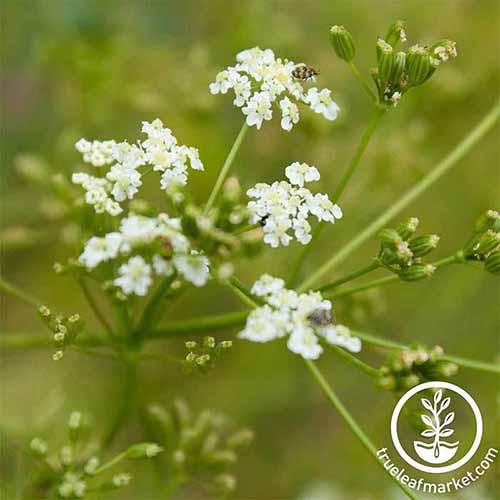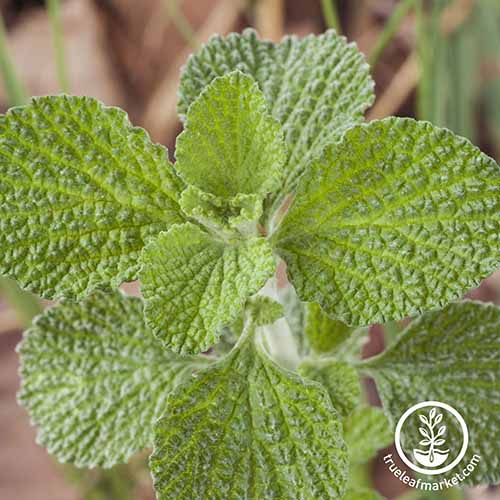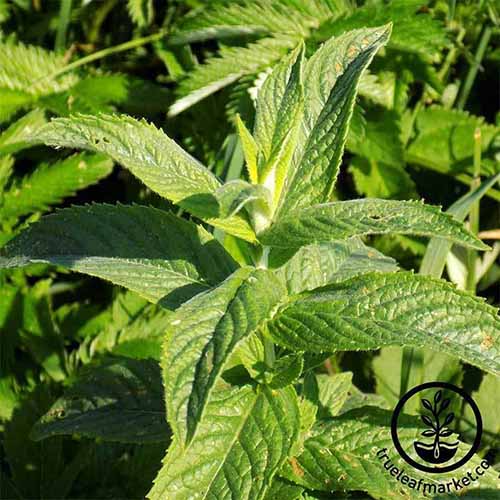Unlike tender annuals, cold-hardy herbs live beyond the growing season, going dormant in the winter and returning again in spring.

We link to vendors to help you find relevant products. If you buy from one of our links,we may earn a commission.
Some herbs, like chives and dill, are herbaceous. They have soft stems that die to the ground with the first frost.
Others, like lavender, are woody and drop their leaves but retain a winter “skeleton,”unless they are pruned at season’s end.
There are also evergreens, like thyme and rosemary, with woody stems and leaves year-round in the warmest regions of their appropriate growing zones.
Get ready to take your herb gardening to the next level with the following 23 cold-hardy culinary and medicinal herbs that withstand winter freezing temperatures and return with vigor.
Let’s jump right into this herb extravaganza!
1. Caraway
If you’ve ever enjoyed seeded rye bread, you are familiar with caraway seeds, which come from the plant known as Carum carvi. Suited to Zones 4 to 10, this herbaceous species prefers full sun and sandy, well-draining loam.
Plants have a bushy growth habit. They are biennials that grow foliage in the first year. In the second, they bloom and set seed. If you don’t harvest all the seeds and let some fall, you will have caraway for years to come, as if your plants were perennials.
Mature dimensions are 24 to 36 inches high with a 12-inch spread.
In addition to classic rye bread, caraway is a signature flavor in sauerkraut.
Caraway seeds are available from True Leaf Market.
See our guide to growing caraway for cultivation instructions.
2. Chives
Chives, Allium schoenoprasum, are perennial herbaceous bulb plants that thrive in Zones 4 to 8 with full sun to part shade. Soil of average quality is adequate, provided it drains well.
Clumps mature to a height and width of 12 to 18 inches.
Related to onions and garlic, chives impart subtle flavors of both, and make an excellent baked potato garnish atop a dollop of sour cream.
Chive plants and seeds are available from Burpee.
Consult our guide to growing chives for more information.
3. Comfrey
Herbaceous comfrey, Symphytum officinale, grows in Zones 4 to 9. It thrives in full sun to part shade and average, well-draining soil.
Comfrey is a perennial herb that grows in clumps that sprout from tubers. It tops out at 12 to 36 inches tall with a spread of nine to 30 inches.
Comfrey is often used to make salves. Beware that the leaves emit a foul, rotten odor during the typical salve fermentation process.
Per the pros at the Missouri Botanical Garden, while the species has a history of topical and internal use, today’s experts consider consumption unsafe.
Comfrey seeds are available from the Palm Beach Herbal Tea Company via Amazon.
Our comfrey grow guide has all the info you need to raise your own.
4. Dill
An herbaceous biennial herb for Zones 2 to 11, dill, Anethum graveolens, requires a full sun placement and average soil that drains well.
Expect mature heights of eight to 48 inches and widths of four to 24 inches, depending upon the variety you select to plant.
Dill’s deeply serrated, feathery foliage and seeds have a light, refreshing fragrance and flavor reminiscent of anise.
There are numerous cultivated varieties from which to choose, like elephant dill, one of the largest cultivars that tops out at 36 to 48 inches.
Elephant dill seeds are available from Burpee.
See our dill growing guide for more information.
5. Fennel
Fennel, Foeniculum vulgare, is a short-lived herbaceous perennial herb that returns annually for three to four years. It grows in Zones 4 to 9 in full sun and organically-rich, well-draining loam.
Florence fennel – or finocchio, as I know it – resembles celery and has anise-like, aromatic bulbs and seeds. The bulbs are sliced and served fresh or cooked as a vegetable side dish. The seeds enhance baked goods.
Florence fennel seeds are available from Botanical Interests.
Learn how to grow fennel in our guide.
6. Horehound
Horehound, Marrubium vulgare, is a perennial suited to Zones 3 to 9 and prefers full sun to part shade, and sandy loam that drains well.
With a shrubby growth habit, horehound develops woody stems that reach up to 30 inches tall with a spread of 24 to 36 inches.
I first tasted horehound as a child, when my grandmother offered me a taste of her favorite ribbon candy. The flavor is full-bodied, with hints of vanilla, root beer, and anise undertones.
Horehound seeds are available from True Leaf Market.
Find complete cultivation instructions and a candy recipe, see our guide to growing horehound.
7. Horseradish
Herbaceous horseradish, Armoracia rusticana, grows in Zones 2 to 9 with full sun to part shade and organically-rich soil that drains well. Beware that this perennial is vigorous and can become invasive.
Common horseradish has broad, crinkly leaves and produces outstanding roots. The Bohemian variety has narrow, smooth foliage, lesser root quality, but better disease resistance.
Mature heights are 24 to 30 inches with a spread of 30 to 36 inches.
Horseradish is grown for its spicy, nose-clearing, eye-watering roots used to make the familiar condiment of the same name.
Horseradish crowns are available from Nature Hills Nursery. A crown is a sprouted root ready for planting.
See our horseradish growing guide for cultivation instructions.
8. Lavender
For Zones 4 to 11, lavender, Lavandulaspp., thrives in full sun and average soil that drains well.
Plants are shrubby, with woody stems that top out at 12 to 36 inches and a spread of 18 to 40 inches.
These perennials typically have lavender blooms, a floral-meets-pine fragrance, and a somewhat bitter flavor. The flowers and foliage have a wide range of uses, including cosmetic, culinary, and curative applications.
Cultivars of the English species, like Lavandulaangustifolia‘Munstead,’ exhibit the best cold hardiness.
‘Munstead’ lavender seeds are available from True Leaf Market. Plants make attractive informal hedges.
See our lavender growing guides for more information about various types and their cultivation.
9. Lemon Balm
Suited to Zones 3 to 10, herbaceous lemon balm, Melissa officinalis, is a perennial herb that grows well in full sun to part shade, and average, well-draining soil.
Plants have a bushy growth habit. Mature heights are 18 to 24 inches with a spread of 18 to 36 inches.
Lemon balm has a history of use in herbal medicine. Its lemony fresh leaves make aromatic garnishes and soothing tea.
Lemon balm seeds are available from Botanical Interests.
Learn more about lemon balm in our guide.
10. Lovage
If you are in Zones 3 to 9, you can enjoy homegrown lovage, Levisticum officinale.
This herbaceous perennial herb resembles celery, but its flavor calls anise or fennel to mind. Cultural requirements include full sun to part shade and average, well-draining soil.
Plants achieve a showy height of three to six feet with a spread of two to three feet.
Tender, young leaves make a flavorful and aromatic change from flat leaf parsley. Older ones tend to be bitter. The stems are equally appealing fresh, in salads, or cooked in various savory entrees and side dishes.
Lovage seeds are available from the Mountain Valley Seed Company via True Leaf Market.
See our guide to growing lovage for cultivation instructions.
11. Mint
Mint, Mentha spp., thrives in Zones 3 to 11 with full sun to part shade and organically-rich loam that drains well. It is aggressive to the point of invasiveness, so even clay soil won’t slow it down.
As these perennials mature, the stems become woody. Mature dimensions are 24 to 36 inches tall and 24 inches wide.
There are many mint species and hybrids, including spearmint, M. spicata, peppermint, Mentha x peperita, mojito mint, Mentha x villosa, chocolate mint, Mentha spicata var. peperita, and apple mint, M. suaveolens.
Uses vary, including garnishing chilled beverages, brewing into tea, and boiling for jelly.
Spearmint seeds are available from the Mountain Valley Seed Company via True Leaf Market.
Read more about mint in our growing guide.
12. Mitsuba
For gardeners in Zones 4 to 9, mitsuba, Cryptotaenia japonica, aka Japanese parsley, requires organically-rich loam that drains well, and a part-shade placement. It tolerates full shade, while full sun may cause scorching.
Mitsuba is an herbaceous perennial herb with tender, clumping stems that reach mature heights of 12 to 24 inches and widths of 12 to 18 inches.
It is versatile, with a slightly bitter, celery-like flavor, for a refreshing garnish or lightly cooked vegetable side dish.
Mitsuba seeds are available from the Kitazawa Seed Company via True Leaf Market.
See our mitsuba growing guide for all you need to know to grow your own.
13. Motherwort
Herbaceous perennial motherwort, Leonurus cardiaca, grows in Zones 4 to 8, where it prefers part shade but tolerates full shade and full sun. Soil of all types is acceptable.
Mature plants average 24 to 48 inches tall and 24 to 36 inches wide. These perennials have a clumping growth habit and a tendency to be weedy and invasive.
Herbal practitioners have long used motherwort to treat women with menstrual and postpartum issues, and those with heart complaints, depression, and anxiety.
The bitter leaves and foliage may cause gastrointestinal and skin reactions if consumed.
From an ornamental perspective, if you have room for it to roam, the spikes of lavender-pink blooms bring welcome color and light to shady woodland settings during the summer months.
Motherwort seeds are available from Smoke Camp Crafts via Amazon.
Consult our guide to growing motherwort for more information.
14. Oregano
Common regano, Origanum vulgare, is a perennial suited to Zones 5 to 10. It does best in full sun and soil of average quality that drains well.
Growth is shrubby with woody stems. Plants mature to 12 to 24 inches tall and 18 to 24 inches wide.
This Mediterranean herb benefits from a three-inch layer of winter mulch to support its cold hardiness. Remove it in the spring when the new shoots appear.
The small, fuzzy, aromatic leaves have a bold, pungent flavor that gives pizza sauce its zest.
Common oregano is also called wild marjoram. It is not to be confused with sweet marjoram, Origanum majorana. Sweet marjoram is not cold hardy.
Many consider Greek oregano, Origanum vulgare var. hirtum, to be the quintessential variety.
Still, others are fans of the milder Italian oregano, Origanum x majoricum, aka hardy marjoram or wild marjoram. It is a hybrid of sweet marjoram, O. majorana, and wild marjoram, O. vulgare.
Greek oregano seeds are available from Botanical Interests.
Italian oregano plants are available from Burpee.
Consult our oregano growing guide for detailed information.
15. Rosemary
Rosemary, Salvia rosmarinus, is suited to Zones 8 to 10, where it thrives in full sun and average soil that drains well.
In addition, there are a number of cold-hardy cultivars suitable for Zones 6 and 7. These include ‘Alcade,’ ‘Arp,’ ‘Athens Blue Spire,’ and ‘Hill’s Hardy.’
Plants are perennial herbs with a shrubby growth habit and woody stems. They grow to substantial proportions of four to six feet tall and six to eight feet wide.
Rosemary is commonly used to season poultry and stuffings, and is prized for its bold piney aroma and piquant bite.
‘Arp’ is a richly aromatic cultivar suitable for Zones 7 to 9 that tops out at 48 inches tall.
S. rosmarinus ‘Arp’ plants are available from Burpee.
You can learn more about how to grow rosemary in our guide.
16. Sage
Common or broadleaf sage, Salvia officinalis, does best in Zones 4 to 8. It grows in full sun and average, well-draining soil.
These perennials have a bushy growth habit and woody stems. They mature to 12 to 36 inches tall and wide.
A classic in turkey stuffing and butternut squash risotto, sage is appreciated for its astringent, bitter, and slightly sweet aroma and flavor.
Sage plants and seeds are available from Burpee.
You’ll find cultivation instructions in our sage growing guide.
17. Sorrel
There are several species of herbaceous perennial sorrel suited to cultivation in Zones 3 to 9, including common sorrel, Rumex acetosa,red-veined dock, R. sanguineus,and French sorrel, R. scutatus.
Cultural requirements include full sun to part shade and organically-rich soil that drains well.
Plants grow in compact clumps. Mature dimensions vary by species and cultivar and range from six to 36 inches tall and 12 to 18 inches wide.
Some describe sorrel as fruity, while others find it tart, like lemon or rhubarb. Its uses are equally varied and range from fresh baby salad greens to hot savory entrees, sides, and soups.
Sorrel seeds are available from Botanical Interests.
See our guide to growing sorrel for cultivation instructions.
18. Sweet Cicely
Herbaceous perennial sweet cicely, Myrrhis odorata, grows in Zones 5 to 9. This herb prefers part shade to full shade and organically-rich soil that is evenly moist. You may succeed in a full sun location, provided you can maintain adequate soil moisture.
Plants grow in clumps of 24 to 48 inches tall and wide.
Also known as sweet chervil or myrrh (not the Biblical type), sweet cicely has a flavor and aroma like licorice or anise. It has long been an herbal remedy for digestive and respiratory complaints in tea and tonic form.
Sweet cicely seeds are available from the Palm Beach Herbal Tea Company via Amazon.
19. Tarragon
Wild tarragon, Artemisia dracunculus, and French tarragon, Artemisia dracunculusvar.sativa, are suited to Zones 4 to 9.
They thrive in light, loamy, well-draining soil. And while they grow in full sun, these herbaceous perennial herbs may do best with some afternoon shade.
Plants mature to 24 to 36 inches tall and 12 to 15 inches wide.
Tarragon has a licorice-like flavor, much like anise or fennel, and is used to flavor fish, meat, poultry, and vegetable dishes.
Another cold-hardy species, Russian tarragon, Artemisia dracunculoides, offers a robust plant but lacks the aroma and flavor intensity of the wild and French types.
French tarragon seeds are available from Burpee.
20. Thyme
Common thyme, Thymus vulgaris, grows in Zones 4 to 8. Cultural requirements include full sun and well-draining sandy loam, but rocky, dry soil is well-tolerated.
These perennials have a bushy growth habit, woody stems, and mature dimensions of five to 18 inches tall and 12 to 18 inches wide.
There are numerous varieties, including creeping ground covers.
An aromatic herb, the flavor of thyme is earthy, minty, and peppery, and it’s a favorite in savory poultry dishes.
Thyme plants and seeds are available from Burpee.
See our thyme grow guide for all you need to know to raise plants.
21. Wild Bergamot
Herbaceous perennial wild bergamot, Monarda fistulosa, is also known as purple bee balm and Oswego tea. It is an herbaceous perennial species suited to USDA Hardiness Zones 3 to 9.
Cultural requirements include full sun to part shade with average, well-draining soil.
Expect mature heights of 36 to 48 inches and a spread 18 to 24 inches wide.
Wild bergamot is a medicinal herb long used by Native Americans for wound care and treating gastrointestinal to respiratory ailments.
It has a licorice-like aroma and flavor. It is often brewed into tea and used as a decorative garnish.
Wild bergamot seeds are available from Botanical Interests.
Learn how to grow Monarda species in our guide.
22. Winter Savory
Winter savory, Satureja montana, is suited to Zones 6 to 9. It grows in full sun and average soil.
This herb is ashrubby perennial with woody stems. Expect mature dimensions of eight to 15 inches tall and 12 to 24 inches wide.
Bolder than summer savory, it has a piquant aroma and flavor comparable to oregano in intensity and is used to spice up bean and beef dishes.
Winter savory seeds are available from True Leaf Market.
Our winter savory growing guide has all you need to know to grow your own.
23. Wintergreen
Wintergreen, Gaultheria procumbens, aka boxberry or teaberry, grows well in Zones 3 to 8. It prefers part shade to full shade and organically-rich, well-draining soil.
Plants are shrubby evergreen perennials. They grow to a low-profile four to six inches tall and spread six to 12 inches wide.
The aromatic, green leaves and red berry-like fruits emit a rich, minty aroma.
Per the Missouri Botanical Garden, while the leaves were once brewed into tea, this is no longer recommended. Instead, they suggest using the flavorful fruits, in moderation, in pastries or salads.
In addition, wintergreen makes an exceptional ornamental ground cover.
Wintergreen plants are available from Burpee.
Cold-Hardy Favorites
With 23 exciting cold-hardy herbs at your disposal, it’s time to choose your favorites.
Use a garden planner to make your list and design an attractive herb garden scheme. Consider mature heights and widths to allow for good airflow and create a visually pleasing display.

Consider locating your cold-hardy herb garden in a sunny spot near the kitchen for easy gathering on an as-needed basis throughout the growing season. Use weatherproof plant tags to mark each type.
At harvest time, head to our sister site, Foodal, to find delicious recipes featuring your favorite cold hardy herbs.
What herbs are you growing? What are your favorites? Share your thoughts in the comments section below.
If you found this roundup informative and would like to learn more about herb cultivation, we suggest the following:
- How to Dry Fresh Garden Herbs
- Tips for Growing an Abundant Edible Herb Garden
- How to Start Your Own Herb Garden























